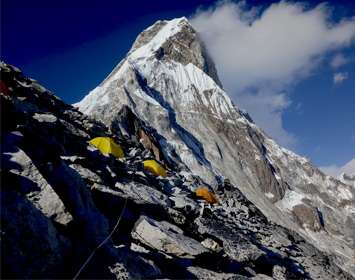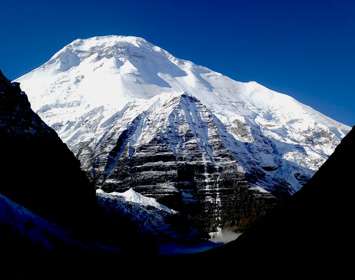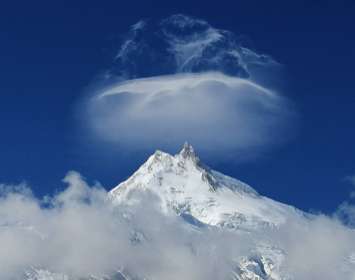Good to Know
South Col Route
Base Camp (17,060ft/5,200m)
The base camp of Mt. Everest is situated on a moving glacier a 5,200 meters from the sea level. Here, you are going to spend many days before pushing towards the summit. During your stay on the base camp, you will be shifting the tents as the ice moves or melts. You will get basic climbing training from the team leader. He will also teach you how to use gears properly and demo you. Likewise, you will go on short excursions to acclimatize and boost your confidence and climb up to Camp I, II, & III and descend back to base camp before embarking towards the summit.
Camp I (19,357ft/5,900m)
From base camp, the route to Camp I is quite strenuous and technical. You will be crossing the challenging Khumbu Icefall, which is 2,000 feet of moving ice with deep crevasses, ice serac, and avalanches from Everest's west shoulder. You will spend two nights at Camp I before moving towards Camp II and descend back to the base camp. In the coming days, you will be climbing Camp I a few more times and move further each time before the final climb. This will help your body to acclimatize.
Camp II (20,998ft/6,400m)
From Camp I, you will gradually ascend to a lateral moraine located at the bottom of the east ridge. While spending time at Camp II, you will stay here. It is a very safe location to spend the night and offers a stunning view of Mt. Lhotse. In the peak season, you will meet with fellow trekkers here as well. Our team will carry all the tents to this point and set it for you. Camp II is base for Camp III and our last permanent camping space. From here onwards, we will try our best to spend as little time as we can on other camps.
Camp III (23,294ft/7,100m)
Leaving Camp II behind, you move towards Camp III. The trail is tough as you have to walk on steep ice using fixed ropes. Your team leader will fix the ropes for safety. As you will be touching very high elevation, the thin air and exposure to cold make this part extremely exhausting. Most of the time, climbers do not need supplemental oxygen at this point in climbing. The angels can range from 30 to 45 degrees. After touching Camp III, you descend back to Camp II for a night stay. After some acclimatization, you will gain push to Camp III and this time with supplemental oxygen if you need to move further towards the summit.
South Col (26,300ft/8,000m)
South Col is like a flat area covered with loose rocks and surrounded by Lhotse on the south & Everest on the north. This is also the Camp IV, our last camp before pushing to the summit of Everest. Again, most of the time climbers do not need to rely on supplemental oxygen to reach here. If you do, we are fully equipped with everything including enough supplemental oxygen. Before reaching the South Col, you have to navigate through two rock sections, the first one is Yellow Band, which is an interlayer of marble phyllite & semi schist rock. The second one is called Geneva Spur, which is an anvil-shaped rib of black rock. You will use a fixed rope to cross these sections.
Summit ( 29,029ft/8,848m)
From Camp IV, it will only take an hour or less to reach the summit of Everest. Before reaching the central summit, you will pass by a Balcony, the Hillary Step, and the South Summit. The route is a moderate snowy slope. The adrenaline rush will keep you moving forward. Upon reaching the top of Everest, you will spend some time, click photos, and descend back to lower camps gradually.
Why go on Everest Expedition with Dream Peak Adventure?
With Dream Peak Adventure, you will be joining a team of like-minded companionable climbers who are willing to reach the summit while supporting each other on every step. We have already summited Everest before and are well-known with the route. While climbing with us, you will get the best standard of equipment and food. All of our meals during the climbing period are cooked by our team. We offer a good variety of meals and snacks to choose from. Furthermore, we make sure that you are getting your required number of calories every day for smooth climbing.
Our teams are small and focused on quality & experience rather than quantity. Our guides are professionally trained and assessed through the International Federation of Mountain Guides Associations (IFMGA) along with other training like rescue, first aid, etc. You will be guided by experienced Sherpas who have successfully led several groups to the summit of Everest before.
Likewise, we provide the latest technologies for advanced communication and weather forecasting. As we closely work with the official weather forecast team of the country, we are well aware of the weather every single moment during the climb. This helps us in the decision making process. At the base camp, we will provide you WiFi and Satellite phone to keep in touch with your loved ones.
At the Everest Base Camp, we will have a dedicated doctor for the entire climbing team who will stand by for any emergency. He will frequently examine you during the stay at the base camp and make sure everything is okay. With all of these services, we also make sure that you are paying the right amount for the expedition. Our Everest expedition cost is well prepared without compromising anything.
Best time to go on Everest Expedition
April and May are the most preferred time to climb Mount Everest. This is the peak time of the year when many mountaineers push towards the summit of Everest. The stable weather and moderate climate make climbing easy. The day time is warmer than nights & mornings. Likewise, the views are also clear and outstanding. Similarly, in the lower elevation, you will see many floras bloomed all over the trail.
Preparation & Physical Fitness
Climbing Everest from South Col is not so much challenging than other routes. However, there are many tough sections and high altitude that makes the journey entirely strenuous and deadly. The trail is physically demanding, requires strong stamina, determination, and will-power. Some days can get 15 hours long as well. Even though most of your loads will be carried by porters, you have to face extreme weather and environment unlike any other place on Earth.
You will be spending more than a month amidst high snow-covered mountains, glaciers, and cold wind. Therefore, it is very important to prepare yourself mentally along with physically. Previous trekking and climbing experience is mandatory to have to go on the Everest Expedition. We have designed our itinerary and planned for the expedition based on our previous experiences. There will be no issues from our side during the journey, and we want you to make sure that you are ready for this extreme challenge before embarking on the journey.
Food & Accommodation
While traveling with us, you will get the best possible accommodation and meals. In the villages, you will be staying in a lodge or guesthouse. You will get basic facilities in the lodge/guesthouse. The rooms are usually small and come with two beds. In most of the places, you will find private washrooms, but many accommodations have common washrooms as well. During the climbing period, you will stay overnight in camp. Our team will carry all the tents to the base camp and other camps. We offer high-quality tents for sleeping, dining, cooking, and washroom.
You can choose meals from the menu of the lodge/guesthouse. They offer a wide variety of dishes from Nepali, Indian, Tibetan, Continental. Likewise, in the camp, you will eat meals cooked by our team members who are professionally trained in cooking a variety of dishes. We provide you enough calories and delicious food during climbing that will keep you moving. Water is available everywhere. You can fill your reusable water bottle in the village. In camps, we will carry gallons of water with ourselves.
Everest Expedition Packing List
We want you to know that you can rent or buy all the gears in Kathmandu. There are several options from medium range brands to high-end brands for all budget types.
- Clothing
- Sun hat/scarf
- Fleece jacket with wind-Stopper
- Waterproof shell jacket
- Down vest and/or jacket
- Lightweight gloves/Heavyweight gloves or mittens with a waterproof shell outer
- Light and expedition weight thermal bottoms
- Fleece/wool pants
- Waterproof (preferably breathable fabric) shell pants
- Thick, warm wool hiking socks
- Hiking boots with spare laces
- Sunglasses with UV protection
Accessories
- Sleeping bag rated to zero degrees Fahrenheit
- Trekking poles
- Headlamp
- Trek bag-pack
- Basic First Aid Kit
- Daypack
- Thermo-rest sleeping pad
- Water bottles
Climbing gears
- Climbing harness
- Ice ax
- crampons
- Mountaineering boots
- AscenderDescender/Abseil device
- Rope
- Snow bar
- Ice hammer
- Helmet (optional)
Toiletries
- Quick-drying towel/Small wash towel
- Soap (biodegradable)
- Toothbrush/paste biodegradable)
- Deodorants
- Face and body moisturizer
- Nail clippers
- Small mirror
- Tissue paper/toilet roll
- Anti-bacterial Hand wash
Extra
- Trail Map/Guide book
- Binocular
- Reading book
- Journal & Pen
- Pencils and small notebooks
- Camera with extra batteries




